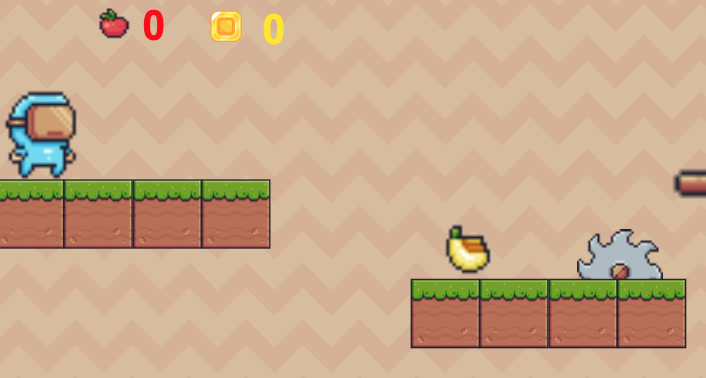
- Game Access: HERE
- Game design document: Fruit-Ninja
Summary
The game Fruit Ninja consists of a walking/jumping ninja that can collect fruits that give him health, and coins that give him points. The ninja has to walk around different platforms, while avoiding obstacles and a variety of enemies that can destroy him or affect his health. To defeat the enemies the ninja has to jump over them; To stop the obstacles, he must collect a tool that will help him do it. In the end, the ninja has to survive to levels to win the game. This game belongs to the platform game genre.
| Target Audiences | Target Platforms |
| · Young kids ages 8-12
· Young adults |
· Windows PC
· Mac · Linux |
Description
Character
The main character is a blue ninja. His main objective is to get to the exit of the second level and win the game by surviving the enemies and obstacles he finds on the way. He will find himself in two different levels: the first one, which has an “earthy” look, contains mainly rotating saw blades and one ninja looking enemy. The second level has a more “brick” look. In this level, he has to destroy the rotating saw blades to get the key to the game’s victory door. While trying to navigate through these two levels, the ninja can collect three different fruits (apples, bananas, pineapples) that help increase his health, as well as coins that give him money points.
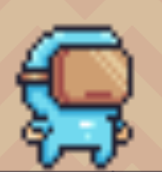
Abilities
The ninja has the ability to walk left and right, with the left and right keyboard arrow. He also has the ability to jump, using the spacebar key. Additionally, the ninja can collect objects like fruits and coins by colliding with them.

Enemies
There are two types of enemies: The living ones, and the object ones. The living one is a green ninja. By jumping over him with the spacebar key, he can destroy them. The second type of enemy and object typed is the spiked brick. This enemy should be avoided at all cost, since the ninja can’t destroy those.


Obstacles
The two main obstacles are the half saw blades and the full rotating saw blades. When the ninja collides with a half saw blade, one of his health points will be subtracted. However, with the full rotating saws, the ninja has to collect the weapon (straight saw chain) to stop the rotating and once he collides with them, the saw blades will disappear.
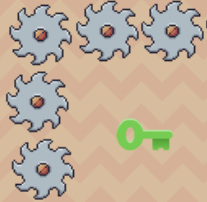

DYNAMICS
User Interface and Difficulty Level
The players can control the game by using the mouse and the keyboard. Arrow keys allow side movement, and spacebar allows the player to jump. Little skill on video game use is needed to play and complete the game. Basic hand coordination and attention is required.
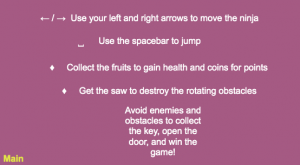
Variables/ Data
There are two visible variables and data shown to the user. First one is health and it is represented by an apple icon. The color for the data shows in red. The second one is points/ money. This variable is represented by a coin and shown in color yellow. As items are collected, the scores will increase. When health of the ninja is affected by an obstacle, the health will decrease.

Initial Game Control
The game FRUIT NINJA will start at a title screen where the user can see the game title, as well as three black buttons. These can be expanded with the use of the mouse, by pressing the left click. The three buttons are:
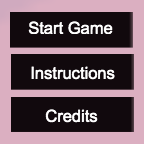
- Start game: once pressed the game will start on level 1.
- Instructions: once pressed a new screen will appear. This will contain basic instructions to understand the game. At the bottom of the screen the text MAIN will appear. By pressing this word, the screen will go back to the title screen.
- Credits: once pressed a screen will appear showing the credits for the resources used for the game. Word MAIN is also at the bottom of this screen.
Once the two levels are completed, a final screen will show with the words “YOU WIN! To restart the game, use the keys (command+r) to refresh and go to the title screen. Else, a “Game over” text will appear over the player and the same restart instruction should be followed.

AESTHETICS
Fruit Ninja is a very clean and simple looking game with pixelated-looking assets. The game was created with the purpose of being minimalistic in the artwork, as well as the use of color pallets, making neutral color the predominant ones.
The game uses 2D graphics for the platforms and animations that move within its location. The text with titles or instructions is all in color black or white. However, the “Game Over” text is shown in bright red color, to surprise and attract the user and provoke excitement and a feeling of anxiousness.
Sound
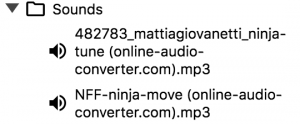
The only sound used for this game was the song “Ninja-tune,” which was acquired from a royalty- free website. The song begins at the start of the layout and will restart in every new layout accessed.
Credits
All assets used for the creation of this game were collected from royalty free websites, for public domain
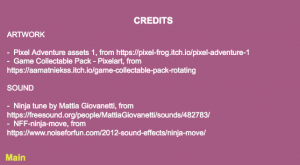
- Artwork:
- Pixel Adventure assets 1, from https://pixel-frog.itch.io/pixel-adventure-1
- Game Collectable Pack – Pixelart, from https://aamatniekss.itch.io/game-collectable-pack-rotating
- Sound:
- Ninja tune by Mattia Giovanetti, from https://freesound.org/people/MattiaGiovanetti/sounds/482783/
- NFF-ninja-move, from https://www.noiseforfun.com/2012-sound-effects/ninja-move/
To the creators of the pixel Adventure assets, thanks a million. Without all of the assets contained in the package, the creation of this game would’ve been impossible. To all of the other creators of art and sound, including Mattia Giovanetti and anonymous artists, whose material was used for the creation of FRUIT NINJA, thank you for the hard work and for making these resources available for free. For students like me, who are in the process of learning how to create games, all these elements are crucial for our success, and without them our learnings and creativity wouldn’t grow and improve. So, thanks again for the generosity and the hard work you put into creating art.
Reflection and Personal experience
For whoever reads this (or even if it is only my Game Design Professor, Dr. Delwiche) creating videogames is/was a fantastic experience and I am very glad I took a leap of faith and chose the game design course. I struggled with health issues during the semester I took the class, so, the completion of this platform game as well as my final project took a bit longer than expected.
Nonetheless, the process of creating this platform game itself took a substantial amount of time. Some of the steps followed to create Fruit Ninja were, first, reading the book “Game development with Construct 2” by Lee Stemkoski and Evan Leider to get some ideas of what type of platform game I wanted to create. Second, I collected assets from different sites and tried to come up with a general idea of what was going to happen in the game (character would collect items and try to make it to the finishing line.) Then, I started to program. This was a HUGE FAILURE. So, a month after, the steps were repeated and I was able to complete the project I had once started.
The main obstacle I encountered the second time around was a big bug that wouldn’t let me run or preview the game. After reading several blogs and sites on what the problem could be, I found that the size of the audio used as background music was too large, and therefore, caused the whole thing to clash. To resolve the issue, I went ahead and converted the audio into an mp3 format and made it smaller. Other issues encountered throughout the process of creating this game were the use of loops, instance variables, and Boolean variables. Silly mistakes like “initially visible” or “false” setting on something that wasn’t supposed to have it, caused me to use at least 2-3 hours of debugging and retrying time. Other than that, past assignments as well as blogs from the Construct3 site were very helpful when trying to solve issues. Additionally, I took some ideas of projects I remembered from the semester and tried to apply them for this game, for example, the use of move to behavior for the title screen, or the use of rotating objects.
In general, and by this point, I feel much more comfortable using Construct3. This skill is not one that can be developed in a week. Instead, it takes a lot of mistakes and time to fully understand the program. Don’t get me wrong though, anyone who has interest on creating games can use it! For my final project, I want to expand in the use of certain behaviors and variables and hopefully, create something more complex where I can show my construct3 abilities. On the meantime, I hope everyone enjoys this platform game and finds something they like about it!
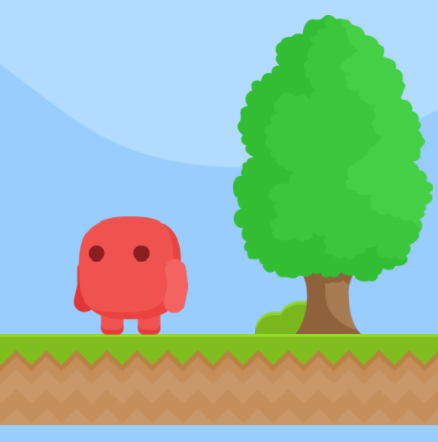
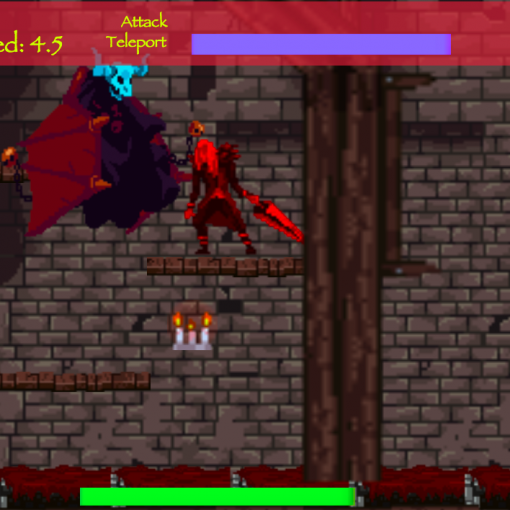
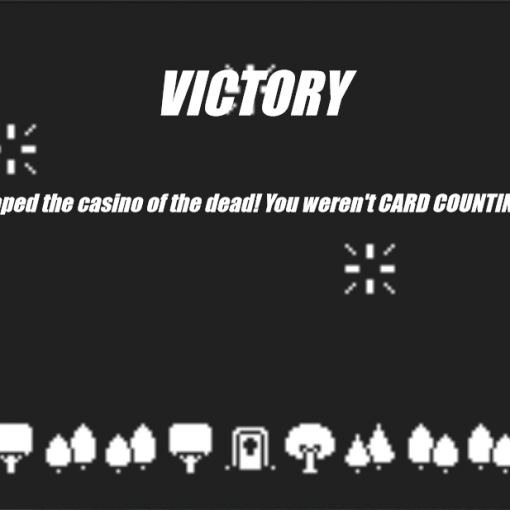
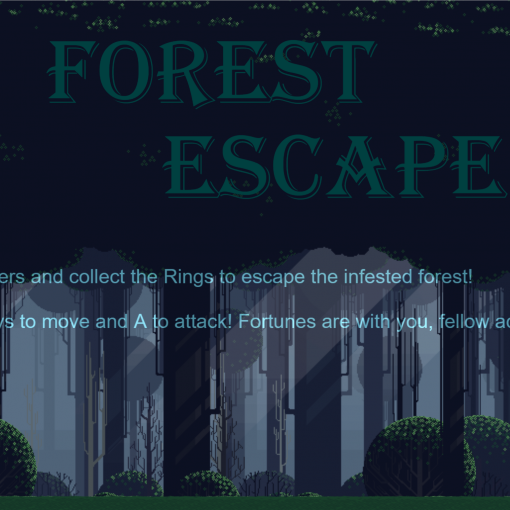
Leave a Reply